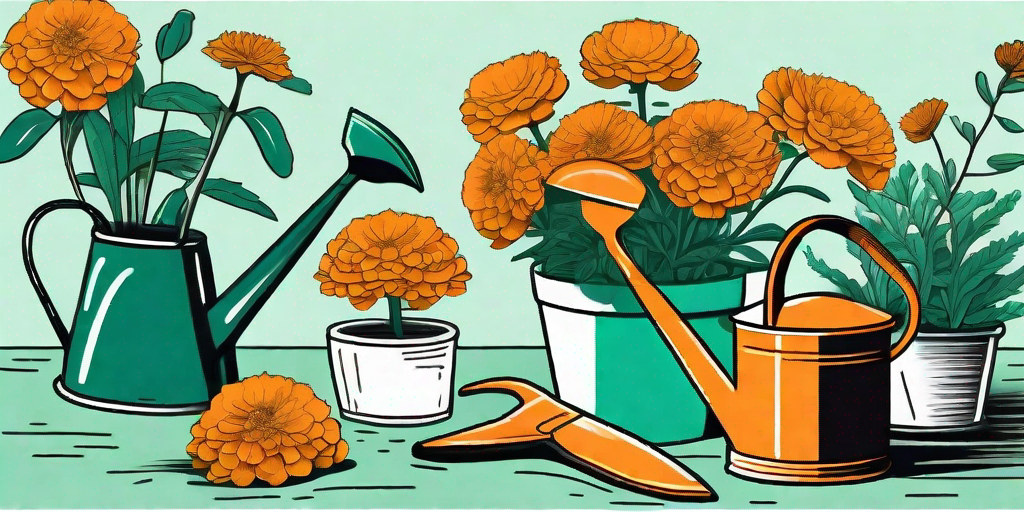
Welcome, green-thumbed enthusiasts and budding botanists! If you're looking to add a splash of sunshine to your garden, look no further than the humble marigold. These blooming beauties are not only a feast for the eyes, but they're also pretty low maintenance, making them perfect for both gardening gurus and those of us who struggle to keep a cactus alive. So, buckle up and get ready to dive into the world of marigolds!
Understanding Your Marigold
Before we get our hands dirty, let's take a moment to appreciate the marigold. Native to the Americas, these vibrant flowers have been brightening up gardens for centuries. They come in a variety of shapes and sizes, from petite French marigolds to the more robust African varieties. But it's not just their looks that make them a garden favorite. Marigolds are known for their pest-repelling properties, making them a natural and decorative solution to keep your garden bug-free.
Marigolds are annuals, meaning they complete their life cycle in one growing season. But don't let that deter you! With their rapid growth and prolific blooming, you'll have plenty of marigold magic to enjoy from spring until frost.
Getting Started
Choosing Your Marigold
First things first, you need to decide which type of marigold tickles your fancy. French marigolds are smaller, with a bushy growth and flowers in shades of red, orange, and yellow. They're perfect for borders and container gardening. African marigolds, on the other hand, are taller with large, pom-pom-like flowers. They make a great statement piece in any garden.
There's also the lesser-known Signet marigold, with its dainty, edible flowers. Yes, you read that right, edible! They add a peppery kick to salads and a pop of color to desserts. So, if you're a foodie with a green thumb, this might be the marigold for you.
Planting Your Marigold
Once you've chosen your marigold, it's time to get planting. Marigolds aren't fussy about soil, but they do prefer it to be well-draining. So, whether you're planting in pots or in the ground, make sure there's adequate drainage to prevent waterlogging. No one likes soggy feet, not even marigolds!
Marigolds love the sun, so choose a spot that gets at least six hours of sunlight a day. Plant your marigolds about 1 to 2 inches deep and 10 to 12 inches apart to give them room to grow. Then, water them well and watch the magic happen!
Caring for Your Marigold
Watering and Feeding
When it comes to watering, marigolds like to play hard to get. They prefer to be slightly dry rather than too wet. So, water them thoroughly, then wait until the top inch of soil is dry before watering again. Overwatering can lead to root rot, which is as nasty as it sounds.
As for feeding, marigolds aren't big eaters. A slow-release fertilizer at the time of planting is usually enough to keep them happy. But if your marigolds are looking a bit peaky, a dose of water-soluble fertilizer should perk them right up.
Pruning and Deadheading
Pruning isn't necessary for marigolds, but deadheading (removing spent flowers) can encourage more blooms. Simply pinch off the faded flowers at the base of the stem. It's a bit like giving your marigold a haircut, and who doesn't love a fresh new do?
Deadheading also prevents your marigold from self-seeding, which can lead to a marigold takeover in your garden. Unless you're going for a marigold jungle, it's best to keep on top of this.
FAQs
- Are marigolds easy to grow?
- Yes, marigolds are very easy to grow, making them perfect for novice gardeners.
- Can marigolds grow in pots?
- Absolutely! Marigolds are quite adaptable and can grow in both pots and garden beds.
- Do marigolds need a lot of sun?
- Marigolds love the sun and need at least six hours of sunlight a day.
- Are marigolds perennials?
- No, marigolds are annuals, which means they complete their life cycle in one growing season.
Conclusion
And there you have it, folks! The foolproof guide to growing and nurturing your blooming marigolds. With their vibrant colors, easy care, and pest-repelling properties, it's no wonder these flowers are a garden favorite. So, why not give marigolds a go? Your garden (and your local bee population) will thank you!
Remember, gardening is all about trial, error, and having fun. So, don't be disheartened if your first marigold doesn't look like it belongs at the Chelsea Flower Show. Keep trying, keep learning, and most importantly, keep enjoying the process. Happy gardening!















